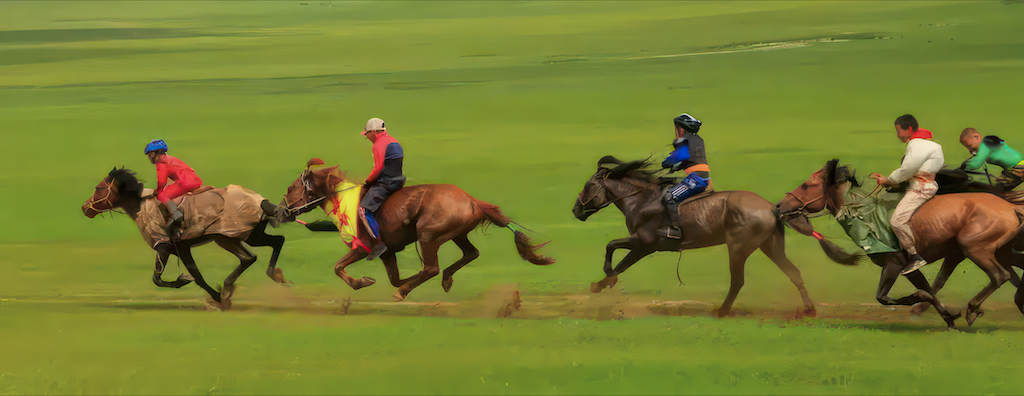A Q&A with Mongolia Destination Expert Anand Munkhuu
Anand Munkhuu, Program Director of Nomadic Expeditions, is a native Mongolian fluent in English and Korean. His professional expertise covers over 22 years in the Mongolian tourism industry. He attended high school in Manhattan while his father worked at the Mongolian Mission to the United Nations. He returned to Ulaanbaatar for university and earned a Bachelor of Accounting from the Institute of Finance and Economics and a Bachelor of Arts from Ulaanbaatar University. He specialized in teaching and interpretation of the Korean language during his studies at Ulaanbaatar University. As Program Director, he designs and often leads trips focused on a paleontological, archaeological and historical nature, as well as adventure-minded trips that include kayaking, eagle hunting, hiking, horse riding, and camel riding. In his spare time, Anand enjoys martial arts, soccer, judo, running, and practicing yoga.
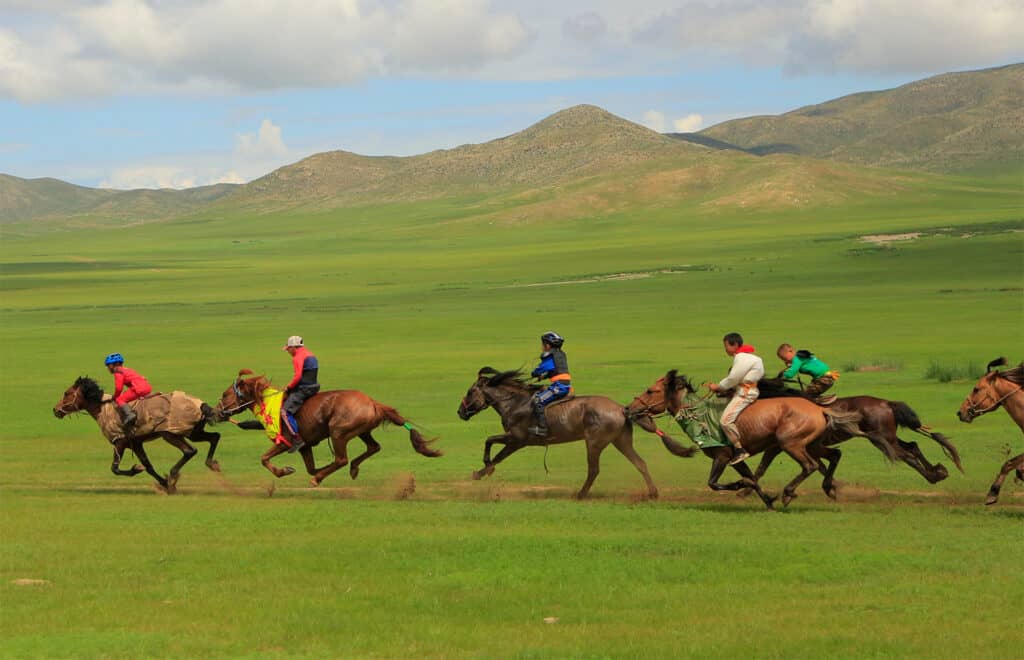
Destination: Naadam Games
How far back do the Naadam Games date, and what was the purpose in forming them?
Historical documents show the early version of Naadam taking place as far back as 2000 years ago. During the times of peace, Naadams were organized as a great way to entertain the people, plus it was a great way to promote sportsmanship amongst the soldiers. After all, every man was drafted to fight. To keep the soldiers in shape, the wrestling was organized. To eliminate the enemy at a long-distance, archery was organized. And to form a battle formation with maneuvers, the horse racing was organized. Today it is quite hard to find a Mongolian boy who has not wrestled and has their own signature move. In the countryside, you can’t find a person who has not ridden a horse by the age of three. And you can’t find a boy who has not fashioned a bow to shoot an arrow. The Naadam games are in our blood.
What is the classic format of the Naadam Games?
Historically it was usually organized in accordance with the lunar calendar. Within the Secret History of Mongolia document written in the 13th century, it tells that the Naadam was organized on the rainy month (Khur Sar/ July). And in the 1600s, the Naadams became religious festivals and known as Danshig Naadam, dedicated to the first Bogd of Mongolia—a rank equivalent to the Dalai Lama in Mongolia. Therefore, the Naadam format hasn’t much changed, only the date.
How old were you when you first attended Mongolia’s national Naadam Games—and what was the experience like?
I was probably 2 or 3 years old. I remember that I attended with my grandparents. The memory that I have is of seeing the wrestling for the first time. I was surprised to see the size of the wrestlers, as they were muscularly built and had this aura of strength and confidence. Next, we saw the archers; I’ve always been fascinated with archery, even today. I still shoot bow and arrows when I have the chance. The archery that I saw was so amazing, the bows were pulled back and the resting arrows were sent to hit the targets at a distance. The people standing on either sides of the targets were telling the archers where the arrows landed with arm and hand gestures while singing. Somehow the gestures looked similar to the semaphore sailors use on battle ships.
Not many people mention this, but the other best part about Naadam culture is tasting the Khuushuur. Khuushuurs are flat dumplings that are deep fried, and you can smell their aroma from a great distance. Today the Mongols go to the Naadam, see the games and go to the stalls to taste the Khuushuur. As a young boy, the Khuushuur experience left quite an impression. It is very common to see many people standing in a long line just to eat the Naadam Khuushuur.
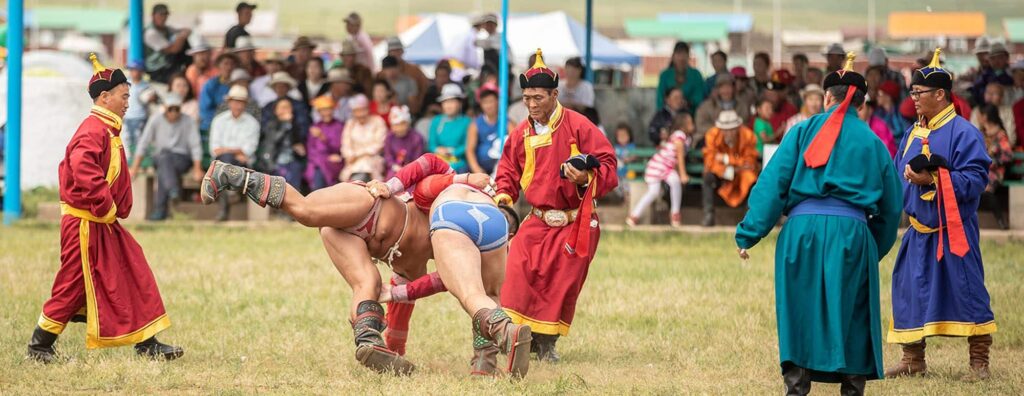
Nomadic expeditions – Classic Mongolia – Naadam Festival
How closely have you participated in any of the Naadam Games events, locally or nationally—or in the production of the events?
I’ve participated in the local Naadam as the announcer, because the Three Camel Lodge organizes its local Naadam and I do get a chance to interact with the wrestlers, archers and the riders all the time. Which is a wonderful experience as you get a chance to learn more in-depth about the training of the wrestlers, how their forefathers were wrestlers and what kind of secret moves they’ve learnt from their fathers. Moreover, you learn how some of the archers make their own bows and why it is important for them to pass on this tradition to their next generation. Finally, I found a whole new respect for the wranglers, as to why they kept their horse bloodlines pristine to keep the next generations of racehorses fast.
Just by interacting with the Naadam participants you learn about how all these traditions came about, how people wait to come to the Naadam, because it’s not just an event you go to, you see people catching up and meeting with new people. Young people come to meet with their future spouses, or simply come and cheer for their favorite wrestler, a renowned horse, or cheer for their favorite archer.
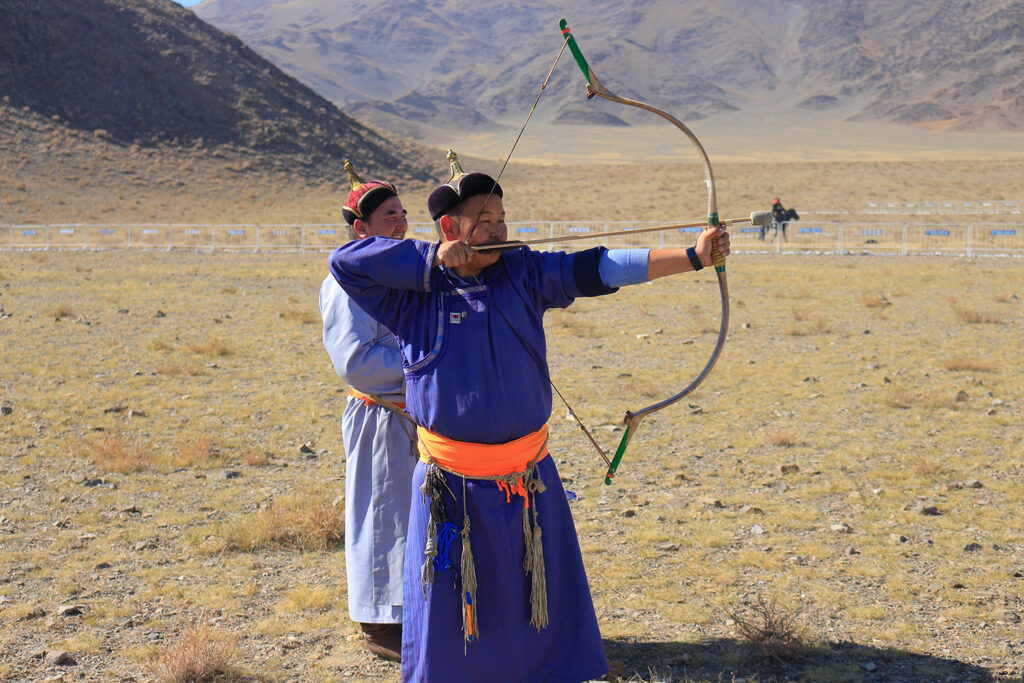
Nomadic Expeditions – Classic Mongolia – Naadam Festival – Archery
Historically and even today, how does Mongolian archery differ from archery of the west?
Historically, Mongols were known for their archery; at great distances the warriors were able to shoot accurately while riding at full gallop. Some even say that the Mongols created the forerunner of the compound bow: the composite bow. There was even a historical document that a grandson of Chinggis, Esunkhe shot a distance of 569 meters. Plus, all Mongol warriors were able to shoot arrows backwards while pretending to retreat.
In comparison, Mongol bows had many important parts that were joined together to form the best bow that was ever used in the world. It consisted of Ibex horns that were cut into curves and joined together. Plus to add strength, a tendon of either deer, cow, horse or camel was used to create the string. When not in use, the string was removed. To fasten the bow with the string, its ends had to be pulled back in to the opposite direction they curved—thus its power. To compare with the western bow, the Mongol bow had much more detailed and stronger parts and therefore was able to shoot at a longer distance with great accuracy. The other factor was that Mongol bows were much smaller compared with the Western bow, and easily be transported while on horseback.
What styles of wrestling are similar to traditional Mongolian wrestling—and what is unique to the style still practiced today?
For me the Mongolian style of wrestling is very much similar to hand-to-hand combat and closely resembles the standing moves and throws of Judo. It is one of the oldest wrestling styles in the world, dating back 7,000 years. Some say that it has 666 moves to bring their opponent down. Therefore, it could be very possible that Mongolian wrestling may have created a foundation for many wrestling styles around the world. With Mongolian wrestling there is no grappling on the ground. The techniques are used to bring the opponent to the ground and that is it—once the opponent’s elbows, knees, back or lower back touches the ground, the match is won.
Because of the wide variety of moves, there are never any boring moments for Mongolian wrestling—and many wrestlers innovate, perfecting a very unique technique to bring down opponents. You see wrestlers employing combinations of single moves, multiple moves in succession, and counter moves. There’s never a dull moment on the wrestling field.
Mongolians have been renowned throughout history for their horses and their horsemanship. What has been so exceptional about Mongolia’s culture of horseback riding, and what sets apart the riders in the events in the Naadam Games?
Mongolia is a horse-based country. Children start to ride horses at the age of 3. Horses have always been intertwined with Mongolian culture. The mode of transportation was horses for thousands of years; the measurement of wealth was once horses; when Mongolia wanted to issue a new currency in the early 1920s, without the backing gold, the imperial white stallions were used to back it.
Today the same principles are still in use. Mongols are using horses for means of transport, mainly to herd their animals, and people still show their wealth with their number of horses.
But above all, Mongols have a belief in a good spirit called a Windhorse. If someone is sad, it is said that the person’s Windhorse is weak. And if someone is happy and energetic, their Windhorse is strong. It is a belief that all good energy and luck are carried on a horse.
As such, five-year-old horses are considered fully mature and having the power to raise one Windhorse. So at the conclusion of the Naadam race of the five-year-old horses, people rush to get a blessing from the sweat of the 5-year-old horses upon their arrival at the finish line.
In can also be summed up that Mongols see everything in the world as nomadic.
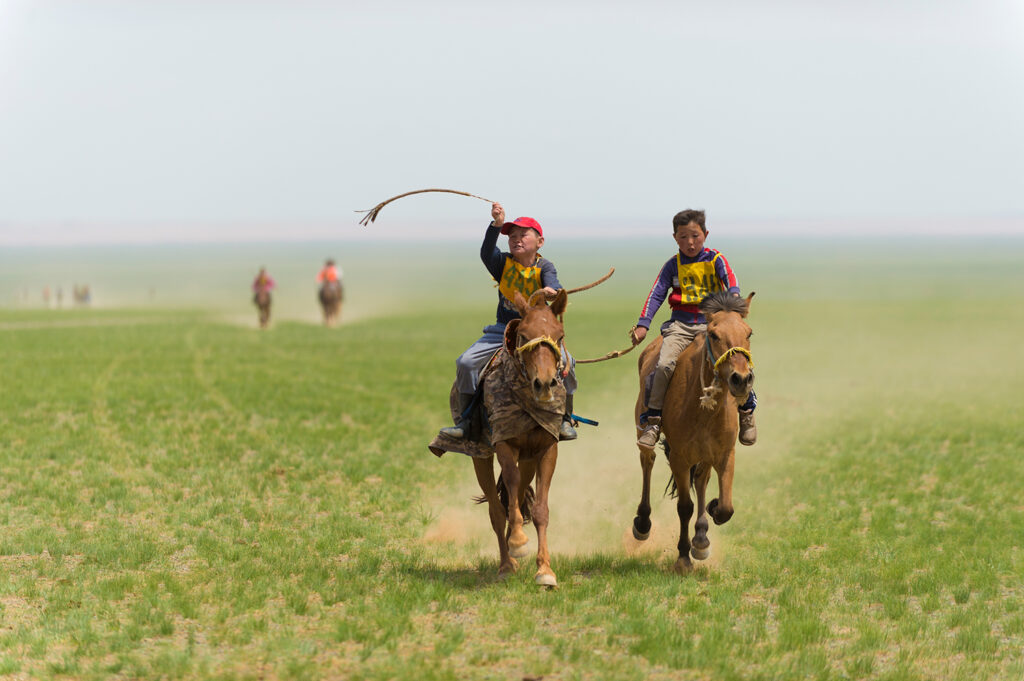
Destination: Naadam Games: Horse Racing
In addition to the three major categories of competition, there are other games that take place. Can you describe one that is unique to Mongolian culture?
For me, I like the ankle bone flicking game, locally known as shagain kharvaa. Today it is part of Naadam games. Dating back to the 13th century, the nobility used to play the game in their gers; later on it was adopted by all and played all over.
To play, the players will be split into teams of 7. Each player will have a piece that they flick from a small palm-size length of board, upon which they place their ankle bone and shoot at the target by flicking the bone at a distance of 4.72 meters (or 9 elbow lengths). Each team will shoot at the targets and whichever team hits the target the most wins. For the Mongols, it is more than a game, it is a game that teaches team play, how to respect the elders and patience.
The national Naadam Games take place in Ulaanbaatar. For people who attend the games, what other cultural excursions would complement the event there in Mongolia’s capital?
The most highly sought-after event that takes place during Naadam is the Deeltei Mongol or Mongols with Deel, a festival of traditional Mongolian apparel festival. On this day, many Mongols come to flaunt their Deels. From a distance, a Deel can be seen as a simple robe that is fixed in place by a belt, a long sash that is wrapped around the belly. But upon closer examination, a Deel has more details and great practicality, as one can use it as a fashion statement, adjust it to suit the weather conditions and many other practical applications.
The participants usually show off their Deels with intricate patterns and detailed embroidery. The winners are selected by judges based on their color combinations, details, fitting and other nuances…
If guests were to venture outside the capital for a day trip, what activities could they combine with their journey?
I highly recommend the Hustai National Park. It’s only 2 hours from the capital, due west. The hills of Hustai are home to the Przewalski’s horses, locally known as the Takhi (meaning “to worship”). Surprisingly, these horses are one of two last remaining wild horses in Central Asia, the other being the Asiatic Wild Ass.
The Przewalski’s horses were last seen in the late 1960s and were not seen again until 1993, when they were reintroduced by bringing in horses from zoos in Europe. Today their number has reached more than 500. You can combine seeing these horses with a great scenic hike or horse ride within the park.
Great additions to this National Park are the red deer, corsak fox, steppe marmot, wolves and predatory birds. Personally, I try to go to Hustai as much as I can with my family, and just being there helps me to be one with nature and feel connected.
When a guest travels to the Nadaam Games, are they able to meet any of the participants to gain a greater appreciation for who’s competing in the contests?
The Ulaanbaatar-held Naadams are quite organized and the competitors are kept separate from the spectators. However, the local Naadams in the countryside are my favorite because everything is held in one place and the people can walk freely around the site and mingle with everyone. This can make the experience more personal. We even had one of our guests participate in the wrestling, and the locals all cheered for him. The guest won the first round and moved on the second, which he lost, but nonetheless, everyone enjoyed the performance. This became a great topic of conversation afterwards. Everyone on hand enjoyed the wrestler’s becoming involved, sharing in the fun of the games.

